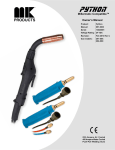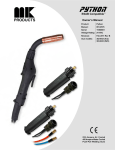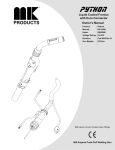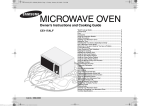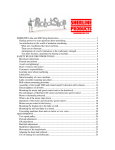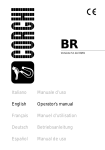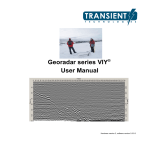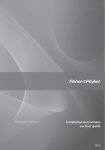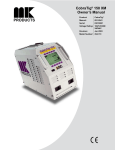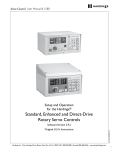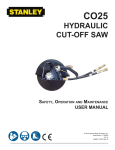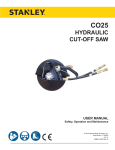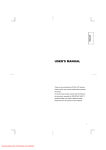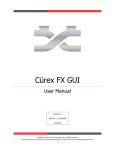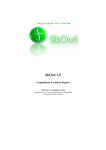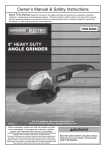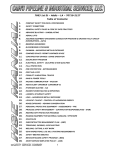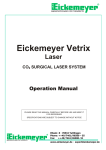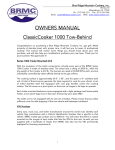Download General Shop Safety Instructions
Transcript
University of Washington, Department of Atmospheric Sciences Machine Shop Facilities General Shop Safety Instructions Shop Safety It is very important to the Atmospheric Sciences Department that the ATG machine Shop be used in a safe manner. All persons who want to use the machine shop are required to read and follow the general safety instructions/rules and all machine related safety instructions. Anybody that violates the shop rules may be barred from using the shop until approval from ATG building coordinator or shop manager for re-admittance. Safety starts with you. Most accidents happen because of carelessness or by not following safety rules. Following basic safety rules and using common sense can make the machine shop a safe and enjoyable experience. Think things out first before you get started, make sure your setups are sound. If you are not sure how to do something, ask the shop manager. Trying to figure something out on your own may result in damage to the machine or injury to you and/or others around you. If you break or damage any tools or equipment you must report it to the shop manager so that it can be repaired or replaced. Take time to familiarize yourself with where everything is in the shop. You should know where the exits are, where the first aid kit is located, where the emergency shut-off switch is located, where the emergency phone is located and where all fire extinguishers are located. Part I 1. Eye protection in the form of safety glasses, face shields, or goggles is required in this area. 2. All machinery, equipment, processes and material is off limits until you have been authorized by Shop personnel. Permission is required for the use of each individual machine in the shop. 3. All injuries or accidents must be reported immediately to the Shop Manager. Accident / incident reports should be filed in a timely fashion. 4. If you are in doubt as to a proper or safe procedure, stop work and ask for guidance. 5. Report unsafe or hazardous conditions wherever noted. Correct them if possible. 6. It is standard safety procedure to work in conjunction with another person at all times. If you are injured, you may be unable to call for help if working alone. 7. Be thoroughly knowledgeable concerning the equipment you are using before you turn it on. Read and understand specific safety and procedural instructions for each different piece of equipment. Know where primary and secondary power cutoff switches are located, and how to use them. Page | 1 8. Have your setup checked by a qualified person before turning on the machine. 9. Long pants are required in the shop area. Open-toed shoes (sandals, etc.) are not allowed. Do not wear loose or torn clothing , neckties, or necklaces. Long hair can easily be caught in drill presses, lathes, milling machines or other machines. Tie back hair or wear a cap. Prevent clothing from being caught in moving machinery. 10.Rings, watches, bracelets, and necklaces should be removed before working in the shop area. These items are easily caught in moving machinery, and may constitute an electrical shock hazard. 11.Use tools for intended purpose only, i.e. do not use screwdrivers as chisels or pry bars, wrenches as hammers, etc. 12.Inspect tools before using. A tool that is dull or in disrepair may not do a proper job and may cause operator harm due to excessive forces required to perform the same work. Examples include dull or chpped edges on cutting tools, drills, or saws, improperly ground screwdrivers or chisels, loose heads on hammers, worn wrenches, etc. DO NOT grind your on tools, unless you have been trained to do so. 13.Do not use fingers or hands to remove chips from moving or stationary machines. Use a brush to remove chips and dispose of them properly. 14.Never direct a stream of compressed air at yourself or others. Say the word “AIR” loudly before using compressed air to clean off a part or machine so you do not startle others working in the shop. Give verbal warning before making loud noises of any kind. 15.Never adjust a moving or rotating machine unless motion is necessary to make adjustment (i.e., a drill press that must be speed adjusted while moving (check with individual machine requirements). Always allow machine to come to a complete standstill before making adjustments or repairs. 16.Approach all powered machinery and equipment as though it is “turned on”. Never leave a machine running while unattended. Some machines are nearly silent when running. 17.Do not attempt to slow down or stop rotating or moving equipment with hands or tools. 18.Remove all non-essential tools, tooling, or material from machine surface prior to tuning on the machine. Vibration may cause these items to fall into moving or rotating equipment. 19.Machined metal, sheared metal, rough castings, etc. can have very sharp and dangerous edges. Always handle with caution and use gloves if possible. However, DO NOT use gloves around rotating or moving machinery. 20.Always clamp or secure work piece properly so that it will not be “thrown” by the machine. Sheet metal and thin parts can ride flutes, rotate at the RPM of the machine and frequently be thrown. Page | 2 21.Clean tapers and make sure they are free of chips before inserting in tailstocks, tapered spindles, etc. 22.Never leave chuck keys in lathe or drill chucks. 23.Welding, cutting, brazing, and related processes can produce toxic fumes, burns, fires, explosions, and electrical shocks. Take appropriate precautions to protect yourself and others in the shop. 24.Use appropriate respiratory protection when working with dusts, mists, fumes or vapors. 25.Use only flint igniters for lighting torches. DO NOT use butane lighters which can explode. 26.Use extreme caution when working around hot metals in welding areas. Hot metals can exhibit little or no visible indication of being hot. 27.Never use a file without a handle installed. 28.Concentrate on what you are doing and do not talk or be distracted while operating equipment. 29.Do not bring food or drinks into any laboratory or shop spaces. Spilled drinks constitute electrical hazards and can damage expensive equipment. 30.Use proper techniques when lifting, moving, or carrying loads. Obtain assistance to distribute loads and avoid strains. Use carts to move heavy vices or work pieces. 31.Watch for tripping hazards and do not place material or objects in thoroughfares or passageways. 32.Know the location of fire extinguishers, fire exits and first aid kits. 33.Be aware of emergency procedures such as: Telephone – Dial 9-911 (Police, fire, Medical) Page | 3 Part II Rules for the use of the Atmospheric Science Shop Facility We want to keep these facilities available for the use of students and faculty of the ATG department to the maximum extent possible while maintaining a reasonable degree of safety and order. We ask that you observe the preceding and following procedures for your own safety, benefit, and enjoyment as well as ours. The following rules regarding the use of the ATG shop facility have been established. 1. INDEPENDENT WORK IS NOT ALLOWED in the shop unless you have been authorized by the person in charge. 2. READ AND OBSERVE THE SAFETY RULES, especially those regarding eye protection and loose clothing. Refer to the previous safety information. 3. YOU MUST CHECK IN WITH THE PERSON IN CHARGE before starting work. 4. YOU MUST FILL OUT A WORKORDER to use the ATG machine shop to include name, department, phone, email, and budget number. 5. RETURN ALL TOOLS AND CLEAN UP. All tools are to be returned clean to their proper places and the area in which you worked is to be cleaned up as indicated. Machine Shop. Clean out chip trays, wipe off machines, oil ways and tool slides, and sweep floor around machines. Welding Shop. Clean off tables, return unused rod to cabinet or container, depose of scrap, coil hoses, secure regulators, and sweep floor of work area. 6. THE SHOP IS ONLY AVAILABLE during times posted. 7. IF YOU NEED HELP OR INSTRUCTION don’t hesitate to ask. We don’t want injuries to you or damage to the equipment any more than you do. Please ask. 8. LET US KNOW IMMEDIATELY if any equipment doesn’t operate properly or needs attention. Also, please inform us of any damage to tools or machines, especially if it occurs while you are using the equipment. Failure to abide by the forgoing rules and safety instructions will result in the denial of use of the ATG shop facilities!! I have read the rules and safety instructions listed above and I will abide by them. Print Name__________________________________ Date______________________________ Signature____________________________________ Department_______________________ Page | 4 University of Washington, Department of Atmospheric Sciences Machine Shop Facilities BAND SAW SAFETY INSTRUCTIONS The band saw is widely regarded as among the safest of all woodworking machinery. However, it is still a dangerous woodworking tool, one that can cause considerable injury if used improperly. In this article, we'll discuss a number of items to keep in mind when using your band saw, to diminish the risk of injury and to help you get the most out of your band saw. Safety Equipment: First and foremost, when working with any metal or woodworking tools, always wear safety glasses. Band saw blades rotate at considerable speed, and small pieces of stock can be propelled in nearly any direction. Even worse, if a blade breaks, the possibility exists that a piece could come loose. Your eyesight is too valuable to take chances working without protective eye wear. Develop the habit of wearing your safety glasses at all times. When using a band saw for metal or woodworking, the noise level would require hearing protection, if you feel more comfortable wearing ear plugs or ear muffs when using your band saw, by all means do so. You should also wear appropriate clothing for working with your band saw. Avoid loose fitting clothing, particularly long sleeved shirts that could get caught in your work or in the band saw blade. Before Every Cut: Once your band saw is adjusted properly and tightened to the appropriate tension level for the blade you're using, you should prepare the saw to make a cut on your stock. With the motor turned off, place the stock to be cut flat on the band saw's table, and lower the blade guards to within 1/8" to 1/4" of the stock. Leaving the blade guards too high will place undue tension on the blade, increasing the likelihood you'll break the blade. Keeping the blade guard within this distance from the stock will also increase the accuracy of your cut. Cutting the Stock Safely: Start up the band saw and wait until the motor is at full speed before beginning any cut. When operating a band saw, always place the stock flat against the table. Do not attempt to "free-hand" the stock in mid-air. The stock must remain flat on the surface of the table at all times during the cut. If a specific, consistent-width rip or specific angle is to be cut, use a band saw rip fence or miter gauge to assist with the cut. Not only will this increase the accuracy of the cut, but it will make the cut safer as well. When cutting curves on the band saw always draw the outline of your projected cut cleanly on the stock you intend to cut. Then, keeping the material flat against the table, ease the stock through the saw along the outer edge of the cut line. It is almost always preferable to leave a slight bit of stock outside the line that can be cleaned up with a spindle sander after completion of the cut, as your band saw blade will likely leave cut marks that need to be sanded smooth. Cutting directly against the cut line will not leave room for sanding. When cutting curves on the band saw always move slowly and methodically throughout the cut. If you must back out of your cut, hold the stock firmly in place with one hand and turn the motor off with the other. Do not attempt to back the stock out of the cut until the blade has come to a complete stop. When cutting tight curves, go slowly and use "relief cuts" wherever possible. These are cuts that cut through scrap portions of your cut out to give you a better angle on accessing a section of your outline. It is safer to make a lot of relief cuts and cut a tight curve in short sections than to try and make one long, inaccurate cut. Page | 5 Keep Your Hands Away: At no time during any of your cuts should your hands be any closer than about three inches from the blade. One hand should be on each side of the stock, easing it through the blade. You should never place your hand directly in the cut line, even if it is more than three inches away. If you must hold the stock closer than three inches, do so only with a push stick. You should also never reach across the band saw. If the on/off switch is on your left, use your left hand to turn it on and off. Other Common Sense Rules: When using your band saw, there will often be very small pieces of stock that are cut off of your big piece of wood during the cutting process. Do not attempt to flick these away from the blade with your fingers. Use another piece of stock or a push stick, preferably with the blade stopped. Often this is not necessary, as the next cut will push the piece safely away from the blade. Once it is clear, push it off of the table. Never leave loose pieces on your table that could impede your cut. When working with machinery, do everything you can to avoid distractions. If someone tries to interrupt you while making a cut, do not avert your eyes from the tool; finish the cut or safely turn off the saw before diverting your attention. Too often, injuries occur because the operator was distracted, even for only a moment. Establish a rule with those around you who might be inclined to interrupt: If they need to disrupt you when working with your woodworking machinery, ask them to wait until the cut is complete before interrupting so you can give your full attention to them. Band Saw Safety Rules 1. Wear safety glasses at all times upon entering a lab situation. 2. Check wood stock for defects before cutting, such as knots, cracks, and foreign objects. 3. Plan sawing procedures so there is a maximum of forward feed and a minimum of backing out. 4. Cut only flat stock whenever possible. When cutting dowels or other round stock, use approved holding device and get permission for this special setup. 5. Be sure the saw blade is the proper width for the job being done. 6. Blades are different widths and may require relief cuts to be made when cutting small radius curves. 7. Hold any wood firmly on the table and not up off the table. 8. Set the upper blade guide ¼” or less above the wood to be cut. 9. Have the supervisor approve all special setups. 10. Always keep fingers out of the path of the blade and a safe distance from the blade. 11. Feed material into the blade at a moderate rate of speed. 12. Allow the machine to come to a complete stop before backing out of a long cut. Do not back out of a cut with the machine running. This can pull the blade off of the wheels. 13. Turn off the power after using the band saw and stand by until the machine has come to a complete stop. 14. Keep the table clear of scraps and clean table of scraps after the blade stops moving. Never pick pieces of wood from the machine while it is in motion and then it is wise to use a push stick or brush. Page | 6 15. Make all adjustments while the machine is off and stopped. 16. When handling long pieces of material, get help and do the pushing yourself. 17. When operating the machine, keep well balanced and stand carefully to avoid injury from unexpected slips or falls. 18. When a band saw blade breaks or comes off the wheels, step away immediately, shut off the power without endangering yourself, and then notify the supervisor. 19. Always keep clear of the area to the right of the band saw when it is being used because if the blade breaks it may whip out into this area. 20. Check the blade for cracks or splits before using the band saw. If a crack is found, unplug the machine and notify the supervisor. 21. Listen for tell-tale sounds as you cut. A clicking sound may mean a cracked blade. 22. When making adjustments it is a wise practice to unplug the machine to avoid accidental starts. * I have read the Band Saw Safety Instructions listed above and I will abide by them. Print Name_____________________________ Signature______________________________ Page | 7 Date___________________________ Department_____________________ University of Washington, Department of Atmospheric Sciences Machine Shop Facilities Grinding Wheel and Grinder Safety 1. Check all wheels for cracks or other damage before mounting. 2. When changing wheels check machine speed against the established maximum safe operating speed marked on wheel. 3. Mount blotters when supplied with wheels. 4. Be sure that the wheel hole, threaded or unthreaded, fits machine arbor properly and that flanges are clean, flat and of the proper type for the wheel you are mounting. 5. Always run wheel in a protected area at least one minute before grinding. 6. Always use the wheel guard furnished with machine. 7. Always wear protective safety glasses and additional eye and face protection if required. 8. Don’t use wheels which have been dropped or otherwise damaged. 9. Never use a grinding wheel that has rated speed less than the speed of the grinder. 10. Don’t use excessive pressure when mounting wheel between flanges. Tighten nut only enough to hold wheel firmly. 11. Don’t use heavy side grinding pressure on any type 1 straight wheel or thin type 27 wheels. 12. Don’t handle grinding machine carelessly . Stop wheel on work and use rack or hooks to support machine when not in use. 13. Don’t mount more than one wheel on a single arbor. 14. NEVER grind aluminum on any wheel in the shop. 15. Set tool rest so that it is within 1/8” inch of the wheel face. Page | 8 16. Types of grinding wheels: a. Aluminum Oxide *White or gray in color *Is for ferrous metals only (excluding iron) *Good for grinding high speed steel cutting tools b. Silicon Carbide *Green in color some time called a “green wheel” *For carbide tools and tungsten welding rods c. Diamond *For high speed steel and carbide tools I have been trained to use the grinder and read the general Grinder Safety Instructions listed above and will abide by them. Print Name_________________________________ Date_______________________________ Signature__________________________________ Department_________________________ Page | 9 University of Washington, Department of Atmospheric Sciences Machine Shop Facilities Drill Press Safety 1. Dress properly. Do not wear gloves, neckties, loose clothing, jewelry, or long hair. 2. Always use safety glasses. 3. Use proper, sharp, clean bits for the job and material. 4. Be sure that the bits can be used on the drill press and the speed they should run. 5. Make sure the drill is tight and remove the chuck key immediately. Never leave the chuck key in the drill chuck. 6. Jog the motor switch to check for wobble in the bit. 7. Always peck drill to prevent long chips from building up on the drill. 8. Always support your work piece with backup material. 9. Always use the right speed for the diameter of drill and material being drilled. The drill press must be running to change speeds. 10.Never use a rag to brush chips off while the machine is running. 11.If the drill binds in the hole, stop the machine and turn the spindle backwards by hand to release the bit. 12.Let the drill press stop on its own after turning it off. Never stop the chuck with your hands. 13.Always center drill/punch before drilling any hole. 14.Whenever possible use column to brace material or fasten material to table or in vice. 15.Clean all drills with a rag and put them in the right place when finished. Always clean the drill press when finished, never clean machine while it is running. I have read rules and safety instructions listed above and will abide by them. Print Name______________________________ Date______________________________ Signature_______________________________ Department________________________ Page | 10 University of Washington, Department of Atmospheric Sciences Machine Shop Facilities Lathe Safety Rules 1. Always wear eye protection - preferably industrial quality safety glasses with side-shields. The lathe can throw off sharp, hot metal chips at considerable speed as well as spin off spirals of metal that can be quite hazardous. Don't take chances with your eyes. Wear hearing protection during extended periods of operation. 2. Wear short sleeve shirts, if possible, or shirts with snugly fitting cuffs if long sleeve. Loose sleeves can catch on rotating work and quickly pull your hand or arm into harm's way. 3. Wear shoes - preferably leather work shoes - to protect your feet from sharp metal chips on the shop floor and from tools and chunks of metal that may get dropped. 4. Remove wrist watches, necklaces, chains and other jewelry. It's a good idea even to remove your wedding ring since it can catch on rotating work and severely damage your ring finger and hand. 5. Tie back long hair so it can't get caught in the rotating work. Think about what happens to your face if your hair gets entangled. 6. Always double check to make sure your work is securely clamped in the chuck or between centers before starting the lathe. Start the lathe at low speed and increase the speed gradually. 7. Get in the habit of removing the chuck key immediately after use. Some users recommend never removing your hand from the chuck key when it is in the chuck. The chuck key can be a lethal projectile if the lathe is started with the chuck key in the chuck. 8. Keep your fingers clear of the rotating work and cutting tools. Do not grasp any chips with your hands, use a hook, brush, or pliers to remove them. If necessary, stop the lathe to remove chips. 9. Avoid reaching over the spinning chuck. For filing operations, hold the tang end of the file in your left hand so that your hand and arm are not above the spinning chuck. 10. Never use a file with a bare tang - the tang could be forced back into your wrist or palm. Inexpensive wooden handles are readily available for common file sizes. 11. Safe, effective use of a lathe requires study and knowledge of procedures for using this tool. Read and thoroughly understand the label warnings on the lathe and in the owner’s/operators manual. 12. Make sure tool bits are sharp and on center. 13. All tool bits taken from the lathe tool drawer must be cleaned and returned when finished. 14. When setting automatic feed, make sure the tool is a safe distance away from the chuck. 15. Stop the lathe before taking measurements. Page | 11 16. Never try to take too heavy of a cut or try to rush through a part. 17. Always clean the machine and make sure that everything is cleaned and put away. Remove tool bits from the tool post and drill chuck before cleaning. * I have read the rules and safety instructions listed above and will abide by them. Print Name_____________________________ Date___________________________ Signature______________________________ Department_____________________ Page | 12 University of Washington, Department of Atmospheric Sciences Machine Shop Facilities Milling Machine Safety Rules 1. Milling machines can be dangerous if not used properly. 2. Read the owner's manual carefully. 3. Make sure you understand instructions and are properly trained before operating a milling machine. 4. Wear appropriate safety glasses. 5. Ensure that the milling machine has a start/stop button within easy reach of the operator. 6. Ensure that the work piece and cutter are mounted securely before taking a cut. 7. Check that work is mounted squarely. 8. Mount work in a vise that is bolted to the table. Use proper hand tools to make adjustments. 9. Take careful steps in holding milling cutters to avoid being cut when handling them. 10. Move table as far as possible from cutter while setting up work to avoid injuring your hands. 11. Mill the largest surface first. 12. Keep hands, brushes and rags away from the revolving milling cutter. 13. Use a vacuum, brush or rake to remove cuttings only after the cutters have stopped moving. 14. Keep cutters sharpened correctly and in good condition. 15. Keep working surface clear of scraps, tools and materials. 16. Keep floor around the milling machine free of oil and grease. 17. Use lifting equipment when appropriate to move heavy work to or from milling machines. 18. Ensure that the following factors are considered when setting cutting speed: 19. material to be machined 20. type of cutter 21. finish required 22. depth of cut 23. rigidity of machine and work piece 24. Do not wear gloves, rings, watches or loose clothing. Tie back long hair. 25. Do not attempt measure or adjust work until cutter is completely stopped. 26. Do not reach over or near a revolving cutter. Keep hands at least 30 cm (12 in.) from a revolving cutter. 27. Do not lean or rest hands on a moving table. 28. Do not make any adjustments while the machine is running. 29. Do not use paper shims to check the distance from the cutter to the stock. 30. Do not move the operating levers without knowing what they control and what action is going to take place. 31. Do not leave machine unattended while it is running. Page | 13 32. Always clean mill when finished. Make sure cutters are removed before cleaning to prevent being cut. I have read the rules and safety instructions listed above and I will abide by them. Print Name____________________________ Date__________________________ Signature_____________________________ Department____________________ Page | 14 University of Washington, Department of Atmospheric Sciences Machine Shop Services Welding General Safety Instructions Page | 15 GENERAL SAFETY PRECAUTIONS GENERAL a. To prevent injury to personnel, extreme caution should be exercised when using any types of welding equipment. Injury can result from fire, explosions, electric shock, or harmful agents. Both the general and specific safety precautions listed below must be strictly observed by workers who weld or cut metals. b. Do not permit unauthorized persons to use welding or cutting equipment. c. Do not weld in a building with wooden floors, unless the floors are protected from hot metal by means of fire resistant fabric, sand, or other fireproof material. Be sure that hot sparks or hot metal will not fall on the operator or on any welding equipment components. d. Remove all flammable material, such as cotton, oil, gasoline, etc., from the vicinity of welding. e. Before welding or cutting, warn those in close proximity who are not protected to wear proper clothing or goggles. f. Remove any assembled parts from the component being welded that may become warped or otherwise damaged by the welding process. g. Do not leave hot rejected electrode stubs, steel scrap, or tools on the floor or around the welding equipment. Accidents and/or fires may occur. h. Keep a suitable fire extinguisher nearby at all times. Ensure the fire extinguisher is in operable condition. i. Mark all hot metal after welding operations are completed. Soapstone is commonly used for this purpose. PERSONAL PROTECTIVE EQUIPMENT a. General. The electric arc is a very powerful source of light, including visible, ultraviolet, and infrared. Protective clothing and equipment must be worn during all welding operations. During all oxyacetylene welding and cutting processes, operators must use safety goggles to protect the eyes from heat, glare, and flying fragments of hot metals. During all electric welding processes, operators must use safety goggles and a hand shield or helmet equipped with a suitable filter glass to protect against the intense ultraviolet and infrared rays. When others are in the vicinity of the electric welding processes, the area must be screened so the arc cannot be seen either directly or by reflection from glass or metal. b. Helmets and Shields. (1) Welding arcs are intensely brilliant lights. They contain a proportion of ultraviolet light which may cause eye damage. For this reason, the arc should never be viewed with the naked eye within a distance of 50.0ft (15.2 m). The brilliance and exact spectrum, and therefore the danger of the light, depends on the welding process, the metals in the arc, the arc atmosphere, the length of the arc, and the welding current. Operators, fitters, and those working nearby need protection against arc radiation. The intensity of the light from the arc increases with increasing current and arc voltage. Arc radiation, like all light radiation, decreases with the square of the distance. Those processes that produce smoke surrounding the arc have a less bright arc since the smoke acts as a filter. The spectrum of the welding arc is similar to that of the sun. Exposure of the skin and eyes to the arc is the same as exposure to the sun. Page | 16 (2) Being closest, the welder needs a helmet to protect his eyes and face from harmful light and particles of hot metal. The welding helmet is generally constructed of a pressed fiber insulating material. It has an adjustable headband that makes it usable by persons with different head sizes. To minimize reflection and glare produced by the intense light, the helmet is dull black in color. It fits over the head and can be swung upward when not welding. The chief advantage of the helmet is that it leaves both hands free, making it possible to hold the work and weld at the same time. (3) The hand-held shield provides the same protection as the helmet, but is held in position by the handle. This type of shield is frequently used by an observer or a person who welds for a short period of time. (4) The protective welding helmet has lens holders used to insert the cover glass and the filter glass or plate. Standard size for the filter plate is 2 x 4-1/4 in. (50 x 108 mm). In some helmets lens holders open or flip upwards. Lenses are designed to prevent flash burns and eye damage by absorption of the infrared and ultraviolet rays produced by the arc. The filter glasses or plates come in various optical densities to filter out various light intensities, depending on the welding process, type of base metal, and the welding current. The color of the lens, usually green, blue, or brown, is an added protection against the intensity of white light or glare. Colored lenses make it possible to clearly see the metal and weld. Table 2-1 lists the proper filter shades to be used. A magnifier lens placed behind the filter glass is sometimes used to provide clear vision. Page | 17 A cover plate should be placed outside the filter glass to protect it from weld spatter. The filter glass must be tempered so that is will not break if hit by flying weld spatter. Filter glasses must be marked showing the manufacturer, the shade number, and the letter “H” indicating it has been treated for impact resistance. NOTE Colored glass must be manufactured in accordance with specifications detailed in the National Safety Code for the Protection of Hands and Eyes of Industrial Workers”, issued by the National Bureau of Standards, Washington DC, and OSHA Standards, Subpart Q, “Welding, Cutting, and Brazing”, graph 1910.252, and American National Standards Institute Standard (ANSI) Z87.11968, “American National Standard Practice for Occupational and Educational Eye and Face Protection”. (5) Gas metal-arc (MIG) welding requires darker filter lenses than shielded metal-arc (stick) welding. The intensity of the ultraviolet radiation emitted during gas metal-arc welding ranges from 5 to 30 times brighter than welding with covered electrodes. (6) Do not weld with cracked or defective shields because penetrating rays from the arc may cause serious burns. Be sure that the colored glass plates are the proper shade for arc welding. Protect the colored glass plate from molten metal spatter by using a cover glass. Page | 18 Replace the cover glass when damaged or spotted by molten metal spatter. (7) Face shields (fig. 2-2) must also be worn where required to protect eyes. Welders must wear safety glasses and chippers and grinders often use face shields in addition to safety glasses. (8) In some welding operations, the use of mask-type respirators is required. Helmets with the "bubble" front design can be adapted for use with respirators. c. Safety Goggles. During all electric welding processes, operators must wear safety goggles (fig. 2-3) to protect their eyes from weld spatter which occasionally gets inside the helmet. These clear goggles also protect the eyes from slag particles, chipping and hot sparks when grinding. Contact lenses should not be worn when welding or working around welders. Tinted safety glasses with side shields are recommended, especially when welders are chipping or grinding. Those working around welders should also wear tinted safety glasses with side shields. d. Protective Clothing. (1) Personnel exposed to the hazards created by welding, cutting, or brazing operations shall be protected by personal protective equipment in accordance with OSHA standards, Subpart I, Personal Protective Equipment, paragraph 1910.132. The appropriate protective clothing (fig. 2-4) required for any welding operation will vary with the size, nature, and location of the work to be performed. Welders should wear work or shop clothes without openings or gaps to prevent arc rays from contacting the skin. Those working close to arc welding should also wear protective clothing. Clothing should always be kept dry, including Page | 19 gloves. (2) Woolen clothing should be worn instead of cotton since wool is not easily burned or damaged by weld spatter and helps to protect the welder from changes in temperature. Cotton clothing, if used, should be chemically treated to reduce its combustibility. All other clothing, such as jumpers or overalls, should be reasonably free from oil or grease. (3) Flameproof aprons or jackets made of leather, fire resistant material, or other suitable material should be worn for protection against spatter of molten metal, radiated heat, and sparks. Capes or shoulder covers made of leather or other suitable materials should be worn during overhead welding or cutting operations. Leather skull caps may be worn under helmets to prevent head burns. (4) Sparks may lodge in rolled-up sleeves, pockets of clothing, or cuffs of overalls and trousers. Therefore, sleeves and collars should be kept buttoned and pockets should be eliminated from the front of overalls and aprons. Trousers and overalls should not be turned up on the outside. For heavy work, fire-resistant leggings, high boots, or other equivalent means should be used. In production work, a sheet metal screen in front of the worker’s legs can provide further protection against sparks and molten metal in cutting operations. (5) Flameproof gauntlet gloves, preferably of leather, should be worn to protect the hands and arms from rays of the arc, molten metal spatter, sparks, and hot metal. Leather gloves should be of sufficient thickness so that they will not shrivel from the heat, burn through, or wear out quickly. Leather gloves should not be used to pick up hot items, since this causes the leather to become stiff and crack. Do not allow oil or grease to come in contact with the gloves as this will reduce their flame resistance and cause them to be readily ignited or charred. e. Protective Equipment. (1) Where there is exposure to sharp or heavy falling objects or a hazard of bumping in confined spaces, hard hats or head protectors must be used. (2) For welding and cutting overhead or in confined spaces, steel-toed boots and ear Page | 20 protection must also be used. When welding in any area, the operation should be adequately screened to protect nearby workers or passers-by from the glare of welding. The screens should be arranged so that no serious restriction of ventilation exists. The screens should be mounted so that they are about 2.0 ft. above the floor unless the work is performed at such a low level that the screen must be extended closer to the floor to protect adjacent workers. The height of the screen is normally 6.0 ft. (1.8 m) but may be higher depending upon the situation. Screen and surrounding areas must be painted with special paints which absorb ultraviolet radiation yet do not create high contrast between the bright and dark areas. Light pastel colors of a zinc or titanium dioxide base paint are recommended. Black paint should not be used. FIRE HAZARDS a. Fire prevention and protection is the responsibility of welders, cutters, and supervisors. Approximately six percent of the fires in industrial plants are caused by cutting and welding which has been done primarily with portable equipment or in areas not specifically designated for such work. The elaboration of basic precautions to be taken for fire prevention during welding or cutting is found in the Standard for Fire Prevention in Use of Cutting and Welding Processes, National Fire Protection Association Standard 51B, 1962. Some of the basic precautions for fire prevention in welding or cutting work are given below. b. During the welding and cutting operations, sparks and molten spatter are formal which sometimes fly considerable distances. Sparks have also fallen through cracks, pipe holes, or other small openings in floors and partitions, starting fires in other areas which temporarily may go unnoticed. For these reasons, welding or cutting should not be done near flammable materials unless every precaution is taken to prevent ignition. c. Hot pieces of base metal may come in contact with combustible materials and start fires. Fires and explosions have also been caused when heat is transmitted through walls of containers to flammable atmospheres or to combustibles within containers. Anything that is combustible or flammable is susceptible to ignition by cutting and welding. d. When welding or cutting parts of vehicles, the oil pan, gasoline tank, and other parts of the vehicle are considered fire hazards and must be removed or effectively shielded from sparks, slag, and molten metal. e. Whenever possible, flammable materials attached to or near equipment requiring welding, brazing, or cutting will be removed. If removal is not practical, a suitable shield of heat resistant material should be used to protect the flammable material. Fire extinguishing equipment, for any type of fire that may be encountered, must be present. HEALTH PROTECTION AND VENTILATION a. General. (1) All welding and thermal cutting operations carried on in confined spaces must be adequately ventilated to prevent the accumulation of toxic materials, combustible gases, or possible oxygen deficiency. Monitoring instruments should be used to detect harmful atmospheres. Where it is impossible to provide adequate ventilation, air-supplied respirators or hose masks approved for this purpose must be used. In these situations, lookouts must be used on the outside of the confined space to ensure the safety of those working within. Requirements in this section have been established for arc and gas welding and cutting. These requirements will govern the amount of contamination to which welders may be exposed: Page | 21 (a) Dimensions of the area in which the welding process takes place (with special regard to height of ceiling). (b) Number of welders in the room. (c) Possible development of hazardous fumes, gases, or dust according to the metals involved. (d) Location of welder's breathing zone with respect to rising plume of fumes. (2) In specific cases, there are other factors involved in which respirator protective devices (ventilation) should be provided to meet the equivalent requirements of this section. They include: (a) Atmospheric conditions. (b) Generated heat. (c) Presence of volatile solvents. (3) In all cases, the required health protection, ventilation standards, and standard operating procedures for new as well as old welding operations should be coordinated and cleaned through the safety inspector and the industrial hygienist having responsibility for the safety and health aspects of the work area. b. Screened Areas. When welding must be performed in a space entirely screened on all sides, the screens shall be arranged so that no serious restriction of ventilation exists. It is desirable to have the screens mounted so that they are about 2.0 ft. (0.6 m) above the floor, unless the work is performed at such a low level that the screen must be extended closer to the floor to protect workers from the glare of welding. See paragraph 2-2 e (3). c. Concentration of Toxic Substances. Local exhaust or general ventilating systems shall be provided and arranged to keep the amount of toxic frees, gas, or dusts below the acceptable concentrations as set by the American National Standard Institute Standard 7.37; the latest Threshold Limit Values (TLV) of the American Conference of Governmental Industrial Hygienists; or the exposure limits as established by Public Law 91-596, Occupational Safety and Health Act of 1970. Compliance shall be determined by sampling of the atmosphere. Samples collected shall reflect the exposure of the persons involved. When a helmet is worn, the samples shall be collected under the helmet. NOTE Where welding operations are incidental to general operations, it is considered good practice to apply local exhaust ventilation to prevent contamination of the general work area. d. Respiratory Protective Equipment. Individual respiratory protective equipment will be well retained. Only respiratory protective equipment approved by the US Bureau of Mines, National Institute of Occupational Safety and Health, or other government-approved testing agency shall be utilized. Guidance for selection, care, and maintenance of respiratory protective equipment is given in Practices for Respiratory Protection, American National Standard Institute Standard 788.2 and TB MED 223. Respiratory protective equipment will not be transferred from one individual to another without being disinfected. e. Precautionary Labels. A number of potentially hazardous materials are used in flux coatings, coverings, and filler metals. These materials, when used in welding and cutting operations, will become hazardous to the welder as they are released into the atmosphere. These include, but are not limited to, the following materials: fluorine compounds, zinc, lead, beryllium, cadmium, and mercury. See paragraph 2-4 i through 2-4 n. The suppliers of welding materials shall determine Page | 22 the hazard, if any, associated with the use of their materials in welding, cutting, etc. (1) All filler metals and fusible granular materials shall carry the following notice, as a minimum, on tags, boxes, or other containers: CAUTION Welding may produce fumes and gases hazardous to health. Avoid breathing these fumes and gases. Use adequate ventilation. See American National Standards Institute Standard Z49.11973, Safety in Welding and Cutting published by the American Welding Society. (2) Brazing (welding) filler metals containing cadmium in significant amounts shall carry the following notice on tags, boxes, or other containers: WARNING CONTAINS CADMIUM - POISONOUS FUMES MAY BE FORMED ON HEATING Do not breathe fumes. Use only with adequate ventilation, such as fume collectors, exhaust ventilators, or air-supplied respirators. See American National Standards Institute Standard Z49.11973. If chest pain, cough, or fever develops after use, call physician immediately. (3) Brazing and gas welding fluxes containing fluorine compounds shall have a cautionary wording. One such wording recommended by the American Welding Society for brazing and gas welding fluxes reads as follows: CAUTION CONTAINS FLUORIDES This flux, when heated, gives off fumes that may irritate eyes, nose, and throat. Avoid fumes--use only in well-ventilated spaces. Avoid contact of flux with eyes or skin. Do not take internally. f. Ventilation for General Welding and Cutting. (1) General. Mechanical ventilation shall be provided when welding or cutting is done on metals not covered in subparagraphs i through p of this section, and under the following conditions: (a) In a space of less than 10,000 cu ft. (284 cu m) per welder. (b) In a room having a ceiling height of less than 16 ft. (5 m). (c) In confined spaces or where the welding space contains partitions, balconies, or other structural barriers to the extent that they significantly obstruct cross ventilation. (2) Minimum rate. Ventilation shall be at the minimum rate of 200 cu ft. per minute (57 cu m) per welder, except where local exhaust heeds, as in paragraph 2-4 g below, or airline respirators approved by the US Bureau of Mines, National Institute of Occupational Safety and Health, or other government-approved testing agency, are used. When welding with rods larger than 3/16 in. (0.48 cm) in diameter, the ventilation shall be higher as shown in the following: Rod diameter (inches) Page | 23 Required ventilation (cfm) 1/4 (0.64 cm) 3500 3/8 (0.95 cm) 4500 Natural ventilation is considered sufficient for welding or cutting operations where the conditions listed above are not present. Figure 2-5 is an illustration of a welding booth equipped with mechanical ventilation sufficient for one welder. g. Local Exhaust Ventilation. Mechanical local exhaust ventilation may be obtained by either of the following means: (1) Hoods. Freely movable hoods or ducts are intended to be placed by the welder as near as practicable to the work being welded. These will provide a rate of airflow sufficient to maintain a velocity the direction of the hood of 100 in linear feet per minute in the zone of welding. The ventilation rates required to accomplish this control velocity using a 3-in. wide flanged suction opening are listed in table 2-2. Page | 24 (2) Fixed enclosure. A fixed enclosure with a top and two or more sides which surrounds the welding or cutting operations will have a rate of airflow sufficient to maintain a velocity away from the welder of not less than 100 linear ft. per minute. Downdraft ventilation tables require 150 cu ft. per minute per square foot of surface area. This rate of exhausted air shall be uniform across the face of the grille. A low volume, high-density fume exhaust device attached to the welding gun collects the fumes as close as possible to the point of origin or at the arc. This method of fume exhaust has become quite popular for the semiautomatic processes, particularly the flux-cored arc welding process. Smoke exhaust systems incorporated in semiautomatic guns provide the most economical exhaust system since they exhaust much less air they eliminate the need for massive air makeup units to provide heated or cooled air to replace the air exhausted. Local ventilation should have a rate of air flow sufficient to maintain a velocity away from the welder of not less than 100 ft. (30 m) per minute. Air velocity is measurable using a manometer or airflow meter. These two systems can be extremely difficult to use when welding other than small welds. The down draft welding work tables are popular in Europe but are used to a limited degree North America. In all cases when local ventilation is used, the exhaust air should be filtered. h. Ventilation in Confined Spaces. (1) Air replacement. Ventilation is a perquisite to work in confined spaces. All welding and cutting operations in confined spaces shall be adequately ventilated to prevent the accumulation of toxic materials or possible oxygen deficiency. This applies not only to the welder but also to helpers and other personnel in the immediate vicinity. (2) Airline respirators. In circumstances where it is impossible to provide adequate ventilation in a confined area, airline respirators or hose masks, approved by the US Bureau of Mines, National Institute of Occupational Safety and Health, or other government-approved testing agency, will be used for this purpose. The air should meet the standards established by Public Law 91-596, Occupational Safety and Health Act of 1970. (3) Self-contained units. In areas immediately hazardous to life, hose masks with blowers or self-contained breathing equipment shall be used. The breathing equipment shall be approved by the US Bureau of Mines or National Institute of Occupational Safety and Health, or other government-approved testing agency. (4) Outside helper. Where welding operations are carried on in confined spaces and where welders and helpers are provided with hose masks, hose masks with blowers, or selfcontained breathing equipment, a worker shall be stationed on the outside of such confined spaces to ensure the safety of those working within. (5) Oxygen for ventilation. Oxygen must never be used for ventilation. i. Fluorine Compounds. (1) General. In confined spaces, welding or cutting involving fluxes, coverings, or other materials which fluorine compounds shall be done in accordance with paragraph 2-4 h, ventilation in confined spaces. A fluorine compound is one that contains fluorine as an element in chemical combination, not as a free gas. (2) Maximum allowable concentration. The need for local exhaust ventilation or airline respirators for welding or cutting in other than confined spaces will depend upon the individual circumstances. However, experience has shown that such protection is desirable for fixed-location production welding and for all production welding on stainless steels. Page | 25 When air samples taken at the welding location indicate that the fluorides liberated are below the maximum allowable concentration, such protection is not necessary. j. Zinc. (1) Confined spaces. In confined spaces, welding or cutting involving zinc-bearing filler metals or metals coated with zinc-bearing materials shall be done in accordance with paragraph 2-4 h, ventilation in confined spaces. (2) Indoors. Indoors, welding or cutting involving zinc-bearing metals or filler metals coated with zinc-bearing materials shall be done in accordance with paragraph 2-4 g. k. Lead. (1) Confined spaces. In confined spaces, welding involving lead-base metals (erroneously called lead-burning) shall be done in accordance with paragraph 2-4 h. (2) Indoors. Indoors, welding involving lead-base metals shall be done in accordance with paragraph 2-4 g, local exhaust ventilation. (3) Local ventilation. In confined spaces or indoors, welding or cutting involving metals containing lead or metals coated with lead-bearing materials, including paint, shall be done using local exhaust ventilation or airline respirators. Outdoors, such operations shall be done using respirator protective equipment approved by the US Bureau of Mines, National Institute of Occupational Safety and Health, or other government-approved testing agency. In all cases, workers in the immediate vicinity of the cutting or welding operation shall be protected as necessary by local exhaust ventilation or airline respirators. l. Beryllium. Welding or cutting indoors, outdoors, or in confined spaces involving berylliumbearing material or filler metals will be done using local exhaust ventilation and airline respirators. This must be performed without exception unless atmospheric tests under the most adverse conditions have established that the workers’ exposure is within the acceptable concentrations of the latest Threshold Limit Values (TLV) of the American Conference of Governmental Industrial Hygienists, or the exposure limits established by Public Law 91-596, Occupational Safety and Health Act of 1970. In all cases, workers in the immediate vicinity of the welding or cutting operations shall be protected as necessary by local exhaust ventilation or airline respirators. m. Cadmium. (1) General. Welding or cutting indoors or in confined spaces involving cadmium-bearing or cadmium-coated base metals will be done using local exhaust ventilation or airline respirators. Outdoors, such operations shall be done using respiratory protective equipment such as fume respirators, approved by the US Bureau of Mines, National Institute of Occupational Safety and Health, or other government-approved testing agency, for such purposes. (2) Confined space. Welding (brazing) involving cadmium-bearing filler metals shall be done using ventilation as prescribed in paragraphs 2-4 g, local exhaust ventilation, and 2-4 h, ventilation in confined spaces, if the work is to be done in a confined space. NOTE Cadmium-free rods are available and can be used in most instances with satisfactory results. n. Mercury. Welding or cutting indoors or in a confined space involving metals coated with mercury-bearing materials, including paint, shall be done using local exhaust ventilation or Page | 26 airline respirators. Outdoors, such operations will be done using respiratory protective equipment approved by the National Institute of Occupational Safety and Health, US Bureau of Mines, or other government-approved testing agency. o. Cleaning Compounds. (1) Manufacturer’s instructions. In the use of cleaning materials, because of their toxicity of flammability, appropriate precautions listed in the manufacturer’s instructions will be followed. (2) Degreasing. Degreasing or other cleaning operations involving chlorinated hydrocarbons will be located so that no vapors from these operations will reach or be drawn into the area surrounding any welding operation. In addition, trichloroethylene should be kept out of atmospheres penetrated by the ultraviolet radiation of gas-shielded welding operations. p. Cutting of Stainless Steels. Oxygen cutting, using either a chemical flux or iron powder, or gasshielded arc cutting of stainless steel will be done using mechanical ventilation adequate to remove the fumes generated. q. First-Aid Equipment. First-aid equipment will be available at all times. On every shift of welding operations, there will be personnel present who are trained to render first-aid. All injuries will be reported as soon as possible for medical attention. First-aid will be rendered until medical attention can be provided. WELDING IN CONFINED SPACES a. A confined space is intended to mean a relatively small or restricted space such as a tank, boiler, pressure vessel, or small compartment of a ship or tank. b. When welding or cutting is being performed in any confined space, the gas cylinders and welding machines shall be left on the outside. Before operations are started, heavy portable equipment mounted on wheels shall be securely blocked to prevent accidental movement. c. Where a welder must enter a confined space through a manhole or other opening, means will be provided for quickly removing him in case of emergency. When safety belts and life lines are used for this purpose, they will be attached to the welder’s body so that he cannot be jammed in a small exit opening. An attendant with a preplanned rescue procedure will be stationed outside to observe the welder at all times and be capable of putting rescue operations into effect. d. When arc welding is suspended for any substantial period of time, such as during lunch or overnight, all electrodes will be removed from the holders with the holders carefully located so that accidental contact cannot occur. The welding machines will be disconnected from the power source. e. In order to eliminate the possibility of gas escaping through leaks or improperly closed valves when gas welding or cutting, the gas and oxygen supply valves will be closed, the regulators released, the gas and oxygen lines bled, and the valves on the torch shut off when the equipment will not be used for a substantial period of time. Where practical, the torch and hose will also be removed from the confined space. f. After welding operations are completed, the welder will mark the hot metal or provide some other means of warning other workers. Page | 27 I have read the Welding General Safety Instructions listed above and will abide by them. Print Name____________________________ Date_______________________________ Signature_____________________________Department__________________________ Page | 28




























